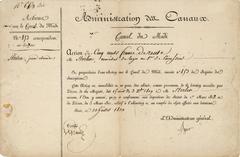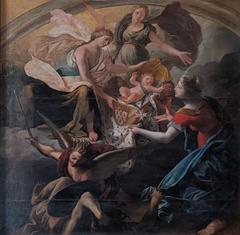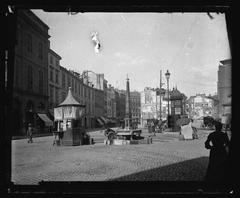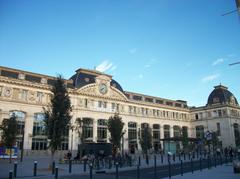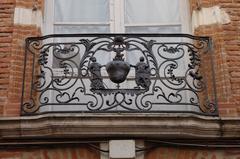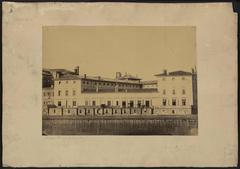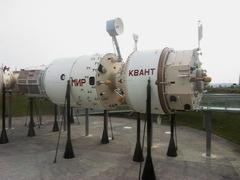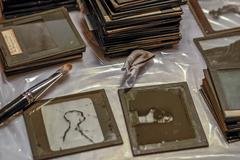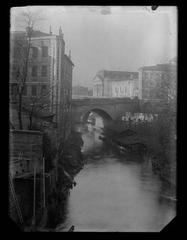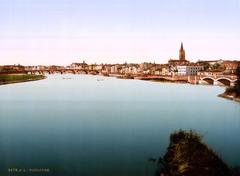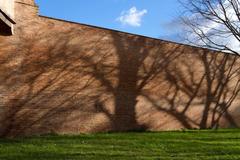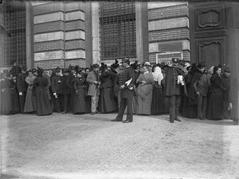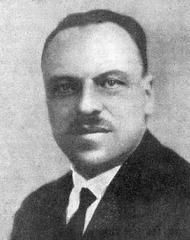
Prison Saint-Michel Toulouse: Visiting Hours, Tickets, and Historical Guide
Date: 04/07/2025
Introduction
Located in the vibrant Saint-Michel district of Toulouse, Prison Saint-Michel stands as a monument to more than 150 years of French penal history, architectural innovation, and powerful collective memory. Designed in the mid-19th century by Jacques-Jean Esquié, this former prison is a pioneering example of the panoptic prison model, reflecting 19th-century ideals of surveillance, order, and moral reform (Monumentum; Wikipedia). The site’s distinctive neo-medieval “Castelet” entrance and star-shaped cell block structure symbolize both authority and architectural prowess, making Prison Saint-Michel a unique landmark within Toulouse’s urban landscape.
Beyond its architectural significance, the prison played a crucial role during World War II as a detention center for resistance fighters and political prisoners under both the Vichy regime and Nazi occupation (La Dépêche; POP Culture). Today, the Castelet, the former administrative entrance, has become a dedicated visitor center and memorial, offering free admission, guided tours, interactive exhibitions, and educational workshops to engage the public with Toulouse’s judicial and wartime history (Toulouse Tourisme; Kidiklik).
This guide provides a thorough overview of Prison Saint-Michel’s origins, architecture, wartime history, visitor information (including hours and tickets), accessibility, nearby attractions, and practical tips. Whether you are a history enthusiast, a cultural traveler, or a local resident, a visit to Prison Saint-Michel connects you to the profound heritage and enduring stories that shaped Toulouse. For the latest updates and enhanced experiences, check official resources and consider the Audiala app for audio guides and interactive maps (Audiala).
Table of Contents
- Origins and Construction
- Architectural Features
- Role During World War II
- Visiting Prison Saint-Michel: Hours, Tickets, and Tips
- Prison Saint-Michel’s Historical Significance
- The Castelet Visitor Experience
- Accessibility and Inclusion
- Annual Commemorations
- Educational and Interpretive Programs
- Urban and Cultural Landscape
- Nearby Attractions
- Practical Information and FAQs
- Special Events and Community Engagement
- Travel Tips and Recommendations
- References
Origins and Construction
Prison Saint-Michel exemplifies 19th-century French penal architecture. Conceived during the Second Empire, it marked a transition towards the cellular prison model—emphasizing surveillance and moral reform. Esquié’s design, begun in 1855 and constructed from 1861, took inspiration from the panoptic model, enabling a single guard to oversee multiple wings from a central rotunda (Monumentum; POP Culture). The prison opened in 1872 after serving briefly as a hospital during the Franco-Prussian War (Wikipedia).
Architectural Features
Saint-Michel was the first French prison built on a panoptic model, with a rotunda and five radiating wings separating inmates by legal category (POP Culture). The Castelet entrance, with its neo-medieval crenellated towers and vaulted gateways, embodies the concept of “architecture parlante”—visually proclaiming the authority and function of the building (Monumentum). The use of brick, iron, and zinc highlighted technological advancements of the era.
Role During World War II
During World War II, Prison Saint-Michel was used by the Vichy regime and Nazi occupiers to detain resistance fighters, Jews, and political dissidents. The prison became a symbol of both repression and courage, with many inmates facing torture, execution, or deportation. The execution of resistance leader Marcel Langer is remembered annually during Toulouse’s Liberation ceremonies. The site also held prominent figures such as André Malraux, who was later freed by the resistance (Wikipedia; La Dépêche).
Visiting Prison Saint-Michel: Hours, Tickets, and Tips
- Visiting Hours:
- Castelet: Wednesday to Sunday, 11:00 AM–6:00 PM.
- Closed Mondays, Tuesdays, and public holidays.
- Special opening hours may apply during events (Kidiklik).
- Admission:
- General entry to the Castelet and its exhibitions is free.
- Guided tours (€3) and creative workshops (€5) are available by reservation.
- Free entry on the first Sunday of each month (Toulouse Tourisme).
- Booking:
- Advance booking for guided tours and workshops is strongly recommended (Billetterie Toulouse).
- Location:
- 18 bis, Grande-Rue Saint-Michel, 31400 Toulouse.
- Accessible by metro (Saint-Michel – Marcel Langer, Line B), tram, bus, and VélÔToulouse bike stations (Haute-Garonne Tourism).
- Parking:
- Limited street parking is available; public transit is recommended.
Prison Saint-Michel’s Historical Significance
The prison is a powerful symbol of Toulouse’s social and judicial history. Its architecture reflects 19th-century aspirations for justice and rehabilitation (Le Busca). Over its 140 years of operation, it housed common criminals, political prisoners, and members of the Resistance, with the Castelet now serving as a memorial and interpretation center (Monumentum).
The Castelet Visitor Experience
Permanent and Temporary Exhibitions
- Architecture and Innovation:
Discover the neo-medieval style, advanced ventilation systems, and the unique star-shaped prison plan (Wikipedia). - Carceral Life:
Interactive displays and oral histories from former staff and inmates reveal the human side of incarceration (Metropole Toulouse). - Resistance and WWII:
Thematic exhibitions pay tribute to the prison’s wartime role and commemorate individuals like Marcel Langer (Culture31). - Featured Exhibitions:
The 2025 “Tatouages et Prisons” exhibition explores the art, symbolism, and social history of prison tattoos (L’Opinion).
Events and Activities
- Guided Tours:
Available Wednesday–Saturday, 4:00–5:00 PM (recommended for ages 12+; max 20 participants). - Workshops:
Creative and educational workshops related to temporary exhibitions. - Cultural Events:
Outdoor cinema, concerts, and special collaborations with local museums.
Accessibility and Facilities
- Accessibility:
The Castelet holds the Tourisme Handicap label and is accessible to visitors with reduced mobility (Haute-Garonne Tourism). - Facilities:
Restrooms and staff assistance available. No café on-site, but many dining options are nearby (Toulouse Tourisme).
Annual Commemorations
Each year, the prison hosts Liberation Day ceremonies honoring victims and resistance fighters. These events reinforce the site’s civic importance and attract broad participation (La Dépêche).
Educational Programs
The Castelet offers guided tours, thematic workshops, and educational resources, with a focus on justice, human rights, and citizenship.
Urban and Cultural Landscape
Prison Saint-Michel is a prominent feature of the Saint-Michel district, influencing local identity and urban development. The site appears in literature and the arts, and ongoing discussions shape its future use (Le Busca).
Nearby Attractions
- Muséum de Toulouse: Natural history museum.
- Jardin des Plantes: Botanical gardens.
- Théâtre Sorano: Performing arts venue.
- Chapelle des Carmélites & Chapelle de la Grave: Historic landmarks.
- Musée départemental de la Résistance et de la Déportation: Complementary exhibitions (Aroundus).
Numerous cafés, bakeries, and restaurants are within walking distance on Grande-Rue Saint-Michel.
Practical Information and FAQs
- Admission: Free for main exhibitions. Guided tours and workshops require booking and a small fee.
- Accessibility: Most areas are accessible; contact staff for special needs.
- Photography: Allowed without flash or tripods, unless otherwise indicated.
- Children: Site is family-friendly, but parental discretion is advised for sensitive content.
Q: Are guided tours available in English?
A: Most are in French; English tours may be offered during special events—please inquire ahead.
Q: Can I take photos inside?
A: Yes, except in restricted areas or exhibitions.
Q: Are there group tours?
A: Yes, groups should book in advance via the official website.
Special Events and Community Engagement
Le Castelet hosts a lively calendar of events, from concerts and open-air cinema to exhibitions like “Tatouages et Prisons.” Collaborations with artists and historians ensure programming remains vibrant and relevant (Culture31).
Travel Tips and Recommendations
- Book guided tours and workshops early (Billetterie Toulouse).
- Visit on weekdays for a quieter experience.
- Use public transport or bikes due to limited parking.
- Extend your visit by exploring the Saint-Michel district and nearby historic sites.
- Download the Audiala app for audio guides and interactive maps (Audiala).



